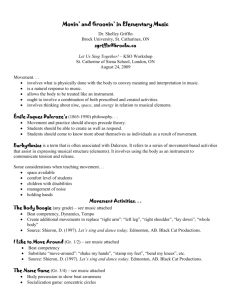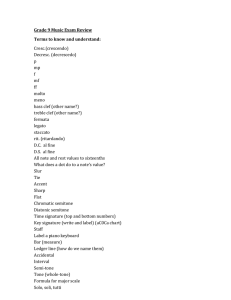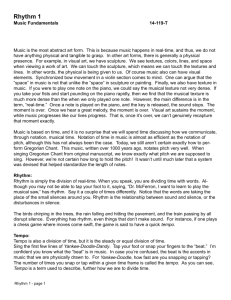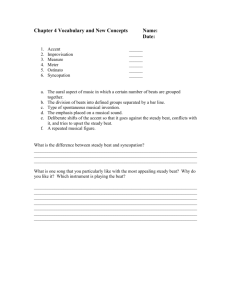Tempo and Beat Analysis
advertisement
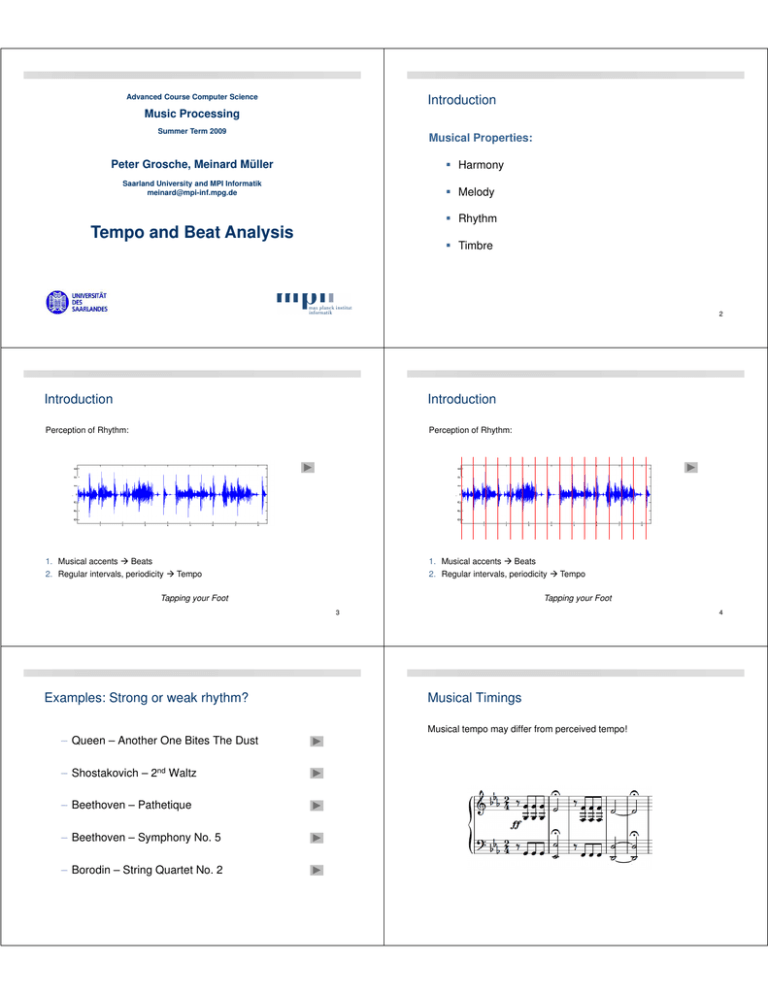
Advanced Course Computer Science Introduction Music Processing Summer Term 2009 Musical Properties: Peter Grosche, Meinard Müller Harmony Saarland University and MPI Informatik meinard@mpi-inf.mpg.de Melody Rhythm Tempo and Beat Analysis Timbre 2 Introduction Introduction Perception of Rhythm: Perception of Rhythm: 1. Musical accents Beats 1. Musical accents Beats 2. Regular intervals, periodicity Tempo 2. Regular intervals, periodicity Tempo Tapping your Foot Tapping your Foot 3 Examples: Strong or weak rhythm? 4 Musical Timings Musical tempo may differ from perceived tempo! – Queen – Another One Bites The Dust – Shostakovich – 2nd Waltz – Beethoven – Pathetique – Beethoven – Symphony No. 5 – Borodin – String Quartet No. 2 Musical Timings Musical Timings Tempo and beat analysis on different time scales: Tempo and beat analysis on different time scales: Tactus (beat) Level Tatum (temporal atom) Level Beat Musical Timings Tempo and beat analysis on different time scales: Measure Level Tatum 1/16 1/8 Beat 1/4 10 Beat Tracking Beat Tracking 1. Impulse Extraction 2. Periodicity Analysis 1. Impulse Extraction 2. Periodicity Analysis Signal Processing 3. Musical Tempo Estimation 4. Tracking the Beat 3. Musical Tempo Estimation 4. Tracking the Beat Musical Knowledge Impulse Extraction Impulse Extraction Musical Accents Onsets: The exact time, a note is hit One of the three parameters defining a note (pitch, onset, duration) Amplitude Change of perceived properties of sound: – Loudness – Pitch – Timbre Rectification Smoothing Differentiation Half wave rectification Time in seconds 14 Impulse Extraction Impulse Extraction Rectification Smoothing Differentiation Half wave rectification Rectification Smoothing Differentiation Half wave rectification Amplitude Amplitude Time in seconds Time in seconds 15 Impulse Extraction Impulse Extraction Rectification Smoothing Differentiation Half wave rectification Rectification Smoothing Differentiation Half wave rectification Amplitude Amplitude 16 Time in seconds Time in seconds 17 18 energy Classical Music energy Classical Music t t Extraction of Transients Extraction of Transients spectrogram | X | Compressed spectrogram Y 1. Spectrogram 1. Spectrogram 2. Log compression 2. Log compression 3. Differentiation 3. Differentiation 4. Integration 4. Integration f f Y = log(1 + C ⋅ | X |) • human sensation • enhances low intensity values • high frequency content • reduces influence of amplitude modulation capture spectral changes: • loudness • pitch • timbre t t 21 Extraction of Transients 22 Extraction of Transients Spectral difference Spectral difference 1. Spectrogram 1. Spectrogram 2. Log compression 2. Log compression 3. Differentiation 3. Differentiation f 4. Integration 4. Integration f t • measure of change • only positive intensity changes • relative difference function Novelty Curve t 23 t 24 Postprocessing Postprocessing Novelty Curve Novelty Curve t t Subtraction of Local Average 25 Novelty Curve 26 Novelty Curve Novelty Curve Novelty Curve t t 27 Peak Picking 28 Examples Peaks as note onset candidates: Shostakovich – 2nd Waltz Novelty Curve Borodin – String Quartet No. 2 t t Periodicity Estimation Fourier Analysis Sinusoidal kernels 30 to 600 BPM, 0.5 to 10 Hz Reveal periodic structure of novelty curve Frequency / Tempo t t 31 Fourier Analysis Fourier Analysis Sinusoidal kernels 30 to 600 BPM, 0.5 to 10 Hz Sinusoidal kernels 30 to 600 BPM, 0.5 to 10 Hz t t Fourier Analysis Fourier Analysis Sinusoidal kernels 30 to 600 BPM, 0.5 to 10 Hz Sinusoidal kernels 30 to 600 BPM, 0.5 to 10 Hz t t Fourier Analysis Fourier Analysis Sinusoidal kernels 30 to 600 BPM, 0.5 to 10 Hz Sinusoidal kernels 30 to 600 BPM, 0.5 to 10 Hz t Fourier Analysis t Tempogram bpm Sinusoidal kernels 30 to 600 BPM, 0.5 to 10 Hz bpm t t bpm Tempogram: Optimal Periodicity Kernels bpm Tempogram bpm t t Examples: – Queen – Another One Bites The Dust – Shostakovich – 2nd Waltz Summary 1. Impulse Extraction • Novelty curve (something is changing, note onsets) • Indicates note onset candidates • Hard task for non-percussive instruments (strings) 2. Periodicity Analysis • Fourier analysis • Detect a tempo (the dominant) – Beethoven – Symphony No. 5 – Borodin – String Quartet No. 2 3. Musical Tempo Estimation • • Define the tempo (quarter beats per minute) Musical knowledge needed (meter, time signature, …) 4. Tracking the Beat • Find most likely beat positions
